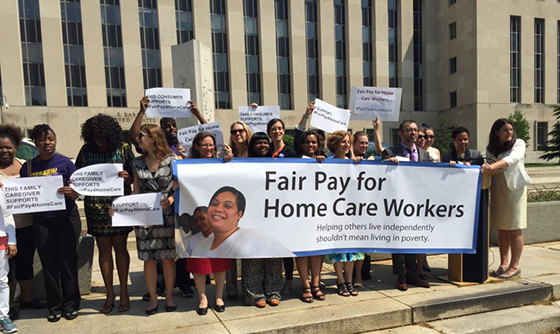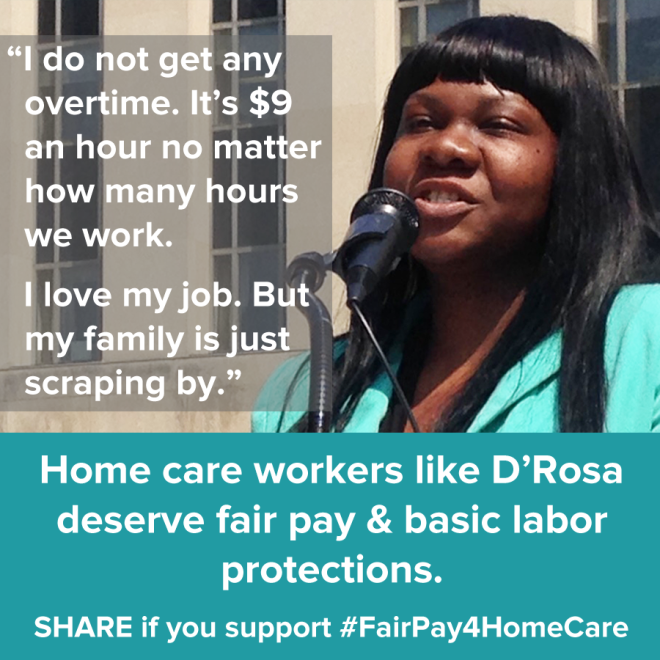Home Care Is Real Work That Deserves a Fair Wage
By Stephanie Román, Economic Policy Analyst, NCLR

Supporters of the Home Care Rule in front of the Federal Courthouse in Washington, DC at the Home Care Rule press conference.
D’Rosa is a home care worker who struggles to make ends meet. She is from Georgia, where she works with elderly adults. At a recent press event in Washington, DC, D’Rosa and other home care workers addressed a crowd of reporters and advocates to make the case that home care work is real work.
D’Rosa spoke about the aspects of her work that she loves—forming strong bonds with her clients—but also its difficulties: “I do not get any overtime. It’s $9 an hour no matter how many hours we work. I love my job, but my family is just scraping by.” Home care workers like D’Rosa are fighting not only for access to minimum wage regulations and overtime protections, but also for recognition and dignity as workers.
D’Rosa’s story is just one of many from home care workers who would benefit from a pending U.S. Department of Labor rule on home care. The much-needed rule would expand minimum wage and overtime rights established by the Fair Labor Standards Act (FLSA) to the two million home care workers who currently lack these basic protections.
Home care workers are predominately immigrant women and women of color. They provide individual care to elderly adults and assist people with disabilities with daily living tasks. NCLR has produced fact sheets and blog posts on these critical yet vulnerable workers.
In January, the Department of Labor took a critical step to address poverty-level wages and a lack of overtime compensation for home care workers by issuing the Home Care Rule to expand FLSA protections. The rule corrects a decades-long injustice of excluding home care workers from basic employment protections. Home care workers were left out of the 1974 update to the FLSA that expanded labor protections to domestic workers.
The proposed rule reflects an increasing recognition of the value of home care work, yet the rule is being challenged in court by home care business associations. The legal challenge could mean that the two million U.S. home care workers who desperately need these protections will continue to struggle financially.

Home care work is physically and emotionally demanding, there is high turnover, and compensation is low. Moreover, employers that pay their employees a living wage can benefit from less turnover, greater productivity, and lower training costs. Home care is a multibillion-dollar industry that is projected to keep growing as the U.S. population ages. By 2020, the home care industry is predicted to grow by 1.3 million jobs, a rate of 70 percent—much faster than the growth rate of 14 percent for all occupations.
Poverty-level wages undermine the economic security of workers and their families and do not equate with the value that home care workers provide. Home care workers make an average of $9.70 per hour. Another estimate, which factors in unpredictable schedules and part-time hours, approximates median annual earnings of just $13,000 for home care workers, leaving one-quarter of home care worker households below the federal poverty line.
It’s difficult to not be moved by the stories of everyday struggle that D’Rosa and others face as home care workers. As a working mother, she’s doing her best to provide for their children with wages that make it nearly impossible. The Department of Labor’s Home Care Rule would help tremendously in making sure that these valued workers can keep caring for our loved ones.